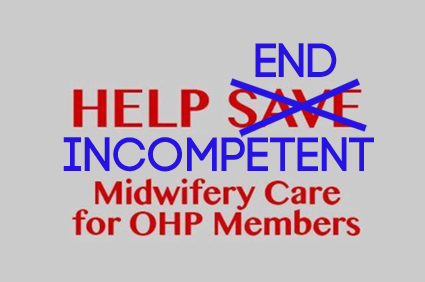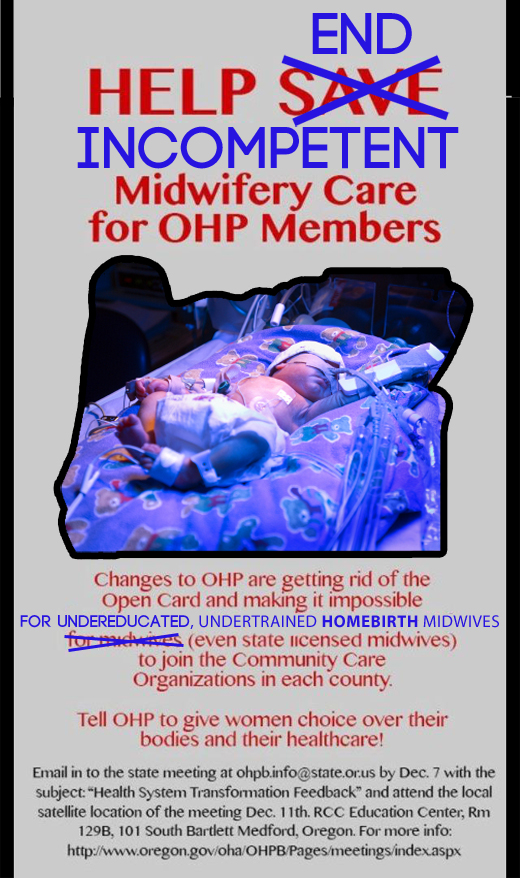Obama care is coming to Oregon and it’s bad news for homebirth midwives.
Big changes are coming with the implementation of President Obama’s Affordable Care Act, and some local midwives are worried that low-income clients from the Oregon Health Plan (OHP) will be lost in the shuffle. OHP services in Lane County have historically been provided through Lane Independent Practice Association and LaneCare, but beginning Nov. 1, those services will be provided by Trillium, Lane County’s new coordinated care organization (CCO).
“We have been covered by the OHP open card, historically, and the open card is going to be going away,” Erin Lusk of Sacred Waters Birthing Center says. “As of now, we’re not included as providers with the new coordinated care organization in the area.”
Since most insurance companies do not pay for undereducated, undertrained homebirth midwives (as opposed to certified nurse midwives), Oregon homebirth midwives have been encouraging their clients to file (fraudulent?) claims in order that to get reimbursement for themselves.
Here’s how it works:
Oregon Health plan essentially has two types of care plans.
Managed Care and Open Card. Managed care contracts with health care agencies to provide members with care in a specified manner. Licensed Midwives in Oregon are not contracted on Managed care contracts and thus are not able to bill for services for clients with this type of insurance.
Open Card is an option primarily created for a)those areas in Oregon (certain counties) that do not have access to Managed Care providers b) Native Americans, and can also be accessed to all people desiring birth with a Licensed Midwife regardless of location in the state of Oregon. Open card is the one way a Licensed Midwife can bill for homebirth costs.
As a Client desiring to obtain Open Card you must wait to apply after 29 weeks of pregnancy. Applying for Oregon Health Plan before 29 weeks will result in denial of Open Card care and often result in being placed on a Managed Care program, which will make it even more difficult if not impossible to change to an Open Card
It is very important when applying for Open Card at 29 weeks or after that you have the appropriate pregnancy verification from a Licensed Midwife stating you are receiving your care from them and plan to birth with them. This will help tremendously in being placed on Open Card. (emphasis in original)
If I understand the Oregon regulations correctly, Open Card is reserved for women who cannot or do not start prenatal care at the beginning of pregnancy. Since it is often extremely difficult to find a provider in the second of third trimester, homebirth midwives were allowed as a last ditch option. Therefore, Oregon homebirth midwives advised their clients NOT to register for insurance at the beginning of pregnancy, but specifically to wait until it was too late to find a real provider.
With the advent of the new health care legislation, Oregon, like all states, has reorganized its public healthcare system to create a CCO (Coordinated Care Organization). Now all providers (even those who provide care as a last resort) must meet the same standards to qualify as providers in the CCO.
The option to trick the State of Oregon into paying homebirth midwives is about to disappear, because all Oregon healthcare providers, including homebirth midwives, will be required to meet the same standards, and one of those standards is having malpractice insurance. Malpractice insurance primarily benefits patients by giving them legal recourse to economic compensation in the event of malpractice. Homebirth midwives don’t carry malpractice insurance because it is expensive.
Oregon homebirth midwives are desperate to retain the ability to get reimbursed for providing care, but they have no intention of meeting the same standards as every other provider. They are fighting back with a marketing campaign, that, as usual, highlights their mendacity.
I have taken the liberty of amending one of their posters to more accurately reflect what is happening.
The first thing to not is that midwifery care in Oregon is NOT in danger. Women will have the same access to certified nurse midwives as they have always had. The only people affected are homebirth midwives who, in many cases, have no formal training in midwifery, and have appallingly high rates of perinatal mortality.
Second, the changes do NOT make it impossible for homebirth midwives to join CCO’s; they are NOT excluding homebirth midwives from CCO’s. Homebirth midwives simply have to follow the SAME rules as all other providers. Homebirth midwives don’t want to follow these rules because it will cut into their profits. Of course malpractice cuts in to the profits of any provider so many would be tempted to go without it. Oregon mandates malpractice insurance as a protection for patients.
Third, homebirth midwives think they can get around the requirements by getting their clients to protest on their behalf. As far as I can determine, they have no intention of ever complying with the same requirements that apply to everyone else.
Oregon homebirth midwives are caught in a bind. They want to be reimbursed like professionals, but they don’t want to meet the standards of professionals. In other words, they want the benefits without any of the burdens.
This may be how Oregon solves the problem of grossly incompetent homebirth midwives who have astronomically high mortality rates: stop paying them until they meet the same standards required of everyone else.



